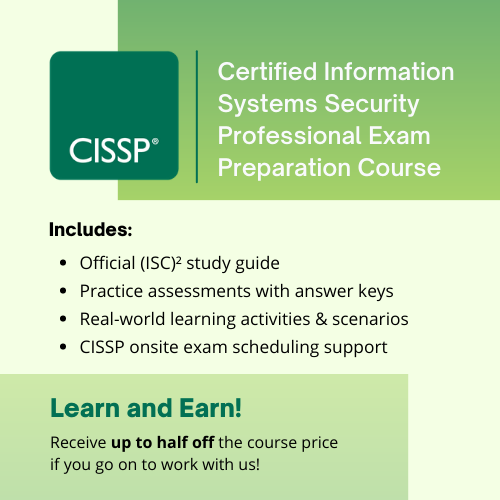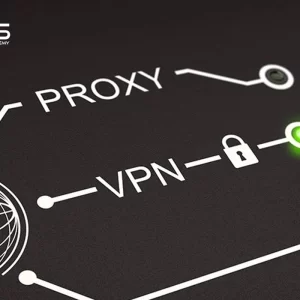Creating Specialized Career Paths In Cybersecurity
Certified Information Systems Security Professional (CISSP) is a program meant to educate, and train learners and professionals having an interest in cyber security and data protection. Curso de preparación para el examen CISSP will help you to validate your expertise in cybersecurity and also give you the right skills to advance your career.
What Is CISSP CERTIFICATION?
The CISSP Certification is one of the prestigious certificates offered by (ISC)², an organization leading the training and certification of cybersecurity.
This Curso de preparación para el examen CISSP training is prepared for professionals who have worked and gained experience in at least 2 out of 8 CISSP domains.
Since CISSP Certification meets the requirements of the DOD (U.S Department Of Defence) it is worth adding the CISSP-certified credential to your resume. Also, this certification complies with the popular ANSI/ISO/IEC 17024 standards.
Who can enroll in the CISSP certification training course?
The CISSP certification course can guide you to build a senior-level career in information security. The enrollment criteria for this course are:
- A minimum of 2 years of experience in networking.
- Basic understanding of Cyber Security, IT networks, and computers.
- Intermediate-level knowledge of cyber security and data protection.
El Curso de preparación para el examen CISSP will also guide you to prepare for the professional cybersecurity examinations, and gain knowledge on the updated security tools and techniques if you are already in this profession. Also, if you are a newbie and want to get a job in cybersecurity, our instructor-led classes will help you to gather fundamental to advance skills.
What Are The Benefits Of Enrolling In The CISSP Exam Preparation Course?
We all understand the fact that the CISSP Course is one of the most demanded security courses in the market. The independent Information Security Certification offered by CCS Learning Academy has got a number of added benefits, mentioned below are of them:
CISSP Exam Preparation Course Offers Better Career Growth:
There is a 2.9 million shortage of CISSP professionals. Therefore, once you complete the course, you really know the examination procedures and criteria. By earning the certification you can evidently succeed in your career and work as an IT Security Consultant or Analyst.
Educates You On The Latest Technology Updates:
Keeping the organization’s data secure is the primary objective of most of the company. This is the reason there is various advancement in IT security. More, data protection tools, resources, software, and procedures are getting invented day by day. But as a professional, you must have the correct knowledge to deploy them. In other words, the CISSP training course will give you astounding knowledge of security tools and techniques.
This certification is globally recognized. Therefore, you get the opportunity to work from any part of the world, and for global organizations too.
CISSP Exam Preparation Course Syllabus
The CISSP (Certified Information Systems Security Professional) Certification Training Course is provided based on the certification rules and regulations set by (ISC)². In addition, we mainly focus on eight domains, mentioned below:
- Domain 1: Security and Risk Management
- Domain 2: Asset Security
- Domain 3: Security Architecture and Engineering
- Domain 4: Communication and Network Security
- Domain 5: Identity and Access Management (IAM)
- Domain 6: Security Assessment and Testing
- Domain 7: Security Operations
- Domain 8: Software Development Security
Why to Choose CCS Learning Academy for CISSP Certification Training Course
CCS Learning Academy unlocks a broad array of exclusive tools, resources, and cybersecurity techniques for learners. Since we are present in the educational industry for over 25 years our experts have hands-on knowledge of all the IT frameworks.
We will give you a broad array of exclusive resources, and guidance on the present-day IT cyber security scenario. Thus, using the instructor’s advice you can easily make a mark in your professional field.
In addition, here are a few points that make us stand up from the rest in the IT educational industry:
- Expert trainer Led training
- Management of Cyber security programs
- Preparation for the CISSP examination
- Training on LIVE projects
To earn the certification you will need education credits. CCS Learning Academy has prepared a relevant CISSP instructor Led training course, comprising all the prerequisites required to score good marks in the examination, and also in your professional fields. Willing to know more about our program, give us a call or email us with our queries. Our experts will connect with you soon!
Course Domains
Domain 1:Security and Risk Management
1.1 Understand, adhere to and promote professional ethics
» (ISC)2 Code of Professional Ethics
» Organizational code of ethics
1.2 Understand and apply security concepts
» Confidentiality, integrity, and availability, authenticity and nonrepudiation
1.3 Evaluate and apply security governance principles
» Alignment of the security function to business strategy, goals, mission, and objectives
» Organizational processes (e.g., acquisitions, divestitures, governance committees)
» Organizational roles and responsibilities
» Security control frameworks
» Due care/due diligence
1.4 Determine compliance and other requirements
» Contractual, legal, industry standards, and regulatory requirements
» Privacy requirements
1.5 Understand legal and regulatory issues that pertain to information security in a holistic context
» Cybercrimes and data breaches
» Licensing and Intellectual Property (IP) requirements
» Import/export controls
» Transborder data flow
» Privacy
1.6 Understand requirements for investigation types (i.e., administrative, criminal, civil, regulatory, industry standards)
1.7 Develop, document, and implement security policy, standards, procedures, and guidelines
1.8 Identify, analyze, and prioritize Business Continuity (BC) requirements
» Business Impact Analysis (BIA)
» Develop and document the scope and the plan
1.9 Contribute to and enforce personnel security policies and procedures
» Candidate screening and hiring
» Employment agreements and policies
» Onboarding, transfers, and termination processes
» Vendor, consultant, and contractor agreements and controls
» Compliance policy requirements
» Privacy policy requirements
1.10 Understand and apply risk management concepts
» Identify threats and vulnerabilities
» Risk assessment/analysis
» Risk response
» Countermeasure selection and implementation
» Applicable types of controls (e.g., preventive, detective, corrective)
» Control assessments (security and privacy)
» Monitoring and measurement
» Reporting
» Continuous improvement (e.g., Risk maturity modeling)
» Risk frameworks
1.11 Understand and apply threat modeling concepts and methodologies
1.12 Apply Supply Chain Risk Management (SCRM) concepts
» Risks associated with hardware, software, and services
» Third-party assessment and monitoring
» Minimum security requirements
» Service level requirements
1.13 Establish and maintain a security awareness, education, and training program
» Methods and techniques to present awareness and training (e.g., social engineering, phishing, security champions, gamification)
» Periodic content reviews
» Program effectiveness evaluation
Domain 2:Asset Security
2.1 Identify and classify information and assets
» Data classification
» Asset Classification
2.2 Establish information and asset handling requirements
2.3 Provision resources securely
» Information and asset ownership
» Asset inventory (e.g., tangible, intangible)
» Asset management
2.4 Manage data lifecycle
» Data roles (i.e., owners, controllers, custodians, processors, users/subjects)
» Data collection
» Data location
» Data maintenance
» Data retention
» Data remanence
» Data destruction
2.5 Ensure appropriate asset retention (e.g., End-of-Life (EOL), End-of-Support (EOS))
2.6 Determine data security controls and compliance requirements
» Data states (e.g., in use, in transit, at rest)
» Scoping and tailoring
» Standards selection
» Data protection methods (e.g., Digital Rights Management (DRM), Data Loss Prevention (DLP), Cloud Access Security Broker (CASB))
Domain 3: Security Architecture and Engineering
3.1 Research, implement, and manage engineering processes using secure design principles
» Threat modeling
» Least privilege
» Defense in depth
» Secure defaults
» Fail securely
» Separation of Duties (SoD)
» Keep it simple
» Zero Trust
» Privacy by design
» Trust but verify
» Shared responsibility
3.2 Understand the fundamental concepts of security models
(e.g., Biba, Star Model, Bell-LaPadula)
3.3 Select controls based upon systems security requirements
3.4 Understand security capabilities of Information Systems (IS) (e.g., memory protection, Trusted Platform Module (TPM), encryption/decryption)
3.5 Assess and mitigate the vulnerabilities of security architectures, designs, and solution elements
» Client-based systems
» Server-based systems
» Database systems
» Cryptographic systems
» Industrial Control Systems (ICS)
» Cloud-based systems (e.g., Software as a Service (SaaS), Infrastructure as a Service (IaaS), Platform as a Service (PaaS))
» Distributed systems
» Internet of Things (IoT)
» Microservices
» Containerization
» Serverless
» Embedded systems
» High-Performance Computing (HPC) systems
» Edge computing systems
» Virtualized systems
3.6 Select and determine cryptographic solutions
» Cryptographic life cycle (e.g., keys, algorithm selection)
» Cryptographic methods (e.g., symmetric, asymmetric, elliptic curves, quantum)
» Public Key Infrastructure (PKI)
» Key management practices
» Digital signatures and digital certificates
» Non-repudiation
» Integrity (e.g., hashing)
3.7 Understand methods of cryptanalytic attacks
» Brute force
» Ciphertext only
» Known plaintext
» Frequency analysis
» Chosen ciphertext
» Implementation attacks
» Side-channel
» Fault injection
» Timing
» Man-in-the-Middle (MITM)
» Pass the hash
» Kerberos exploitation
» Ransomware
3.8 Apply security principles to site and facility design
3.9 Design site and facility security controls
» Wiring closets/intermediate distribution facilities
» Server rooms/data centers
» Media storage facilities
» Evidence storage
» Restricted and work area security
» Utilities and Heating, Ventilation, and Air Conditioning (HVAC)
» Environmental issues
» Fire prevention, detection, and suppression
» Power (e.g., redundant, backup)
Domain 4: Communication and Network Security
4.1 Assess and implement secure design principles in network architectures
» Open System Interconnection (OSI) and Transmission Control Protocol/Internet Protocol (TCP/IP) models
» Internet Protocol (IP) networking (e.g., Internet Protocol Security (IPSec), Internet Protocol (IP) v4/6)
» Secure protocols
» Implications of multilayer protocols
» Converged protocols (e.g., Fiber Channel Over Ethernet (FCoE),
Internet Small Computer Systems Interface (iSCSI), Voice over Internet Protocol (VoIP))
» Micro-segmentation (e.g., Software Defined Networks (SDN), Virtual eXtensible Local Area Network (VXLAN), Encapsulation, Software-Defined Wide Area Network (SD-WAN))
» Wireless networks (e.g., Li-Fi, Wi-Fi, Zigbee, satellite)
» Cellular networks (e.g., 4G, 5G)
» Content Distribution Networks (CDN)
4.2 Secure network components
»Operation of hardware (e.g., redundant power, warranty, support)
» Transmission media
» Network Access Control (NAC) devices
» Endpoint security
4.3 Implement secure communication channels according to design
» Voice
» Multimedia collaboration
» Remote access
» Data communications
» Virtualized networks
» Third-party connectivity
Domain 5: Identity and Access Management (IAM)
5.1 Control physical and logical access to assets
» Information
» Systems
» Devices
» Facilities
» Applications
5.2 Manage identification and authentication of people, devices, and services
» Identity Management (IdM) implementation
» Single/Multi-Factor Authentication (MFA)
» Accountability
» Session management
» Registration, proofing, and establishment of identity
» Federated Identity Management (FIM)
» Credential management systems
» Single Sign On (SSO)
» Just-In-Time (JIT)
5.3 Federated identity with a third-party service
» On-premise
» Cloud
» Hybrid
5.4 Implement and manage authorization mechanisms
» Role Based Access Control (RBAC)
» Rule based access control
» Mandatory Access Control (MAC)
» Discretionary Access Control (DAC)
» Attribute Based Access Control (ABAC)
» Risk based access control
5.5 Manage the identity and access provisioning lifecycle
» Account access review (e.g., user, system, service)
» Provisioning and deprovisioning (e.g., on /off boarding and transfers)
» Role definition (e.g., people assigned to new roles)
» Privilege escalation (e.g., managed service accounts, use of sudo, minimizing its use)
5.6 Implement authentication systems
» OpenID Connect (OIDC)/Open Authorization (Oauth)
» Security Assertion Markup Language (SAML)
» Kerberos
» Remote Authentication Dial-In User Service (RADIUS)/Terminal Access Controller Access Control System Plus (TACACS+)
Domain 6: Security Assessment and Testing
6.1 Design and validate assessment, test, and audit strategies
» Internal
» External
» Third-party
6.2 Conduct security control testing
» Vulnerability assessment
» Penetration testing
» Log reviews
» Synthetic transactions
» Code review and testing
» Misuse case testing
» Test coverage analysis
» Interface testing
» Breach attack simulations
» Compliance checks
6.3 Collect security process data (e.g., technical and administrative)
» Account management
» Management review and approval
» Key performance and risk indicators
» Backup verification data
» Training and awareness
» Disaster Recovery (DR) and Business Continuity (BC)
6.4 Analyze test output and generate report
» Remediation
» Exception handling
» Ethical disclosure
6.5 Conduct or facilitate security audits
» Internal
» External
» Third-party
Domain 7: Security Operations
7.1 Understand and comply with investigations
» Evidence collection and handling
» Reporting and documentation
» Investigative techniques
» Digital forensics tools, tactics, and procedures
» Artifacts (e.g., computer, network, mobile device)
7.2 Conduct logging and monitoring activities
» Intrusion detection and prevention
» Security Information and Event Management (SIEM)
» Continuous monitoring
» Egress monitoring
» Log management
» Threat intelligence (e.g., threat feeds, threat hunting)
» User and Entity Behavior Analytics (UEBA)
7.3 Perform Configuration Management (CM) (e.g., provisioning, baselining, automation)
7.4 Apply foundational security operations concepts
» Need-to-know/least privilege
» Separation of Duties (SoD) and responsibilities
» Privileged account management
» Job rotation
» Service Level Agreements (SLAs)
7.5 Apply resource protection
» Media management
» Media protection techniques
7.6 Conduct incident management
» Detection
» Response
» Mitigation
» Reporting
» Recovery
» Remediation
» Lessons learned
7.7 Operate and maintain detective and preventative measures
» Firewalls (e.g., next generation, web application, network)
» Intrusion Detection Systems (IDS) and Intrusion Prevention Systems (IPS)
» Whitelisting/blacklisting
» Third-party provided security services
» Sandboxing
» Honeypots/honeynets
» Anti-malware
» Machine learning and Artificial Intelligence (AI) based tools
7.8 Implement and support patch and vulnerability management
7.9 Understand and participate in change management processes
7.10 Implement recovery strategies
» Backup storage strategies
» Recovery site strategies
» Multiple processing sites
» System resilience, High Availability (HA), Quality of Service (QoS), and fault tolerance
7.11 Implement Disaster Recovery (DR) processes
» Response
» Personnel
» Communications
» Assessment
» Restoration
» Training and awareness
» Lessons learned
7.12 Test Disaster Recovery Plans (DRP)
» Read-through/tabletop
» Walkthrough
» Simulation
» Parallel
» Full interruption
7.13 Participate in Business Continuity (BC) planning and exercises
7.14 Implement and manage physical security
» Perimeter security controls
» Internal security controls
7.15 Address personnel safety and security concerns
» Travel
» Security training and awareness
» Emergency management
» Duress
Domain 8: Software Development Security
8.1 Understand and integrate security in the Software Development Life Cycle (SDLC)
» Development methodologies (e.g., Agile, Waterfall, DevOps, DevSecOps)
» Maturity models (e.g., Capability Maturity Model (CMM), Software Assurance Maturity Model (SAMM))
» Operation and maintenance
» Change management
» Integrated Product Team (IPT)
8.2 Identify and apply security controls in software development ecosystems
» Programming languages
» Libraries
» Tool sets
» Integrated Development Environment (IDE)
» Runtime
» Continuous Integration and Continuous Delivery (CI/CD)
» Security Orchestration, Automation, and Response (SOAR)
» Software Configuration Management (SCM)
» Code repositories
» Application security testing (e.g., Static Application Security Testing (SAST), Dynamic Application Security Testing (DAST))
8.3 Assess the effectiveness of software security
» Auditing and logging of changes
» Risk analysis and mitigation
8.4 Assess security impact of acquired software
» Commercial-off-the-shelf (COTS)
» Open source
» Third-party
» Managed services (e.g., Software as a Service (SaaS), Infrastructure as a Service (IaaS), Platform as a Service (PaaS))
8.5 Define and apply secure coding guidelines and standards
» Security weaknesses and vulnerabilities at the source-code level
» Security of Application Programming Interfaces (APIs)
» Secure coding practices
» Software-defined security











